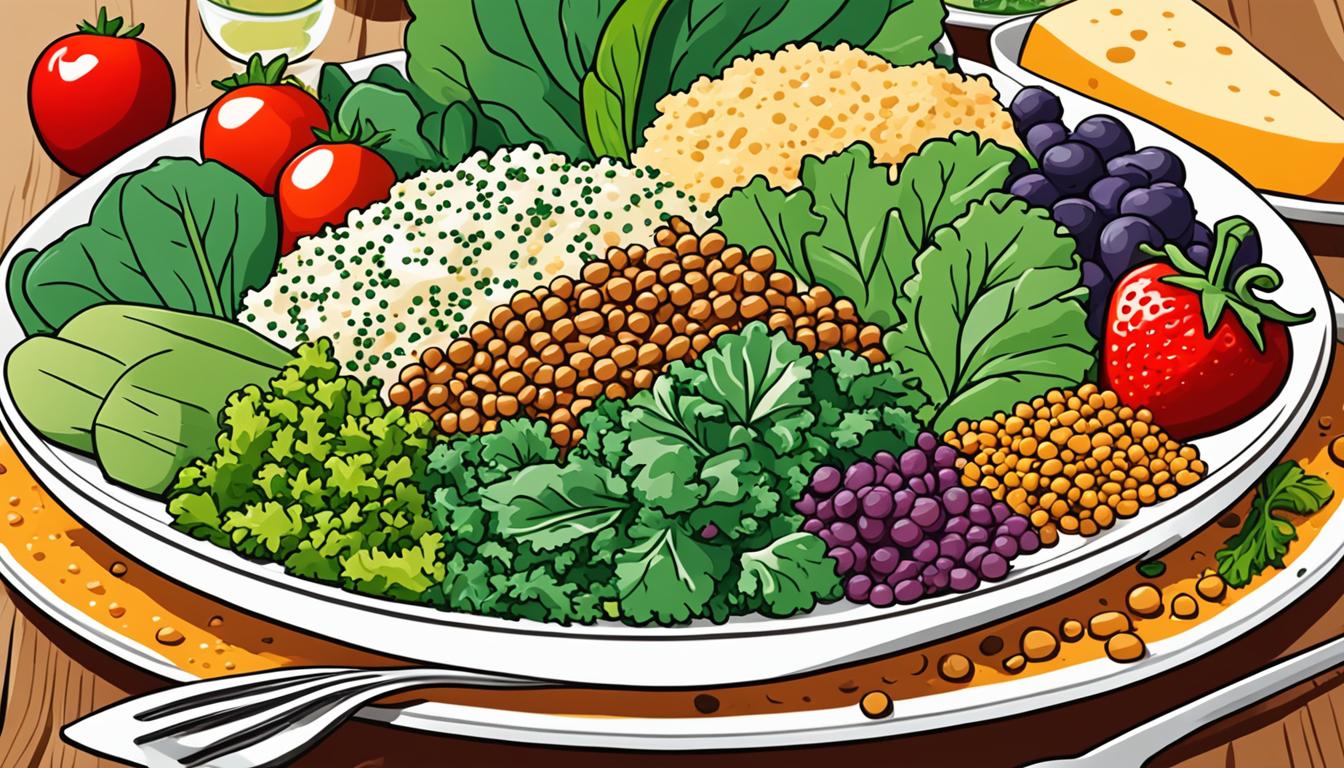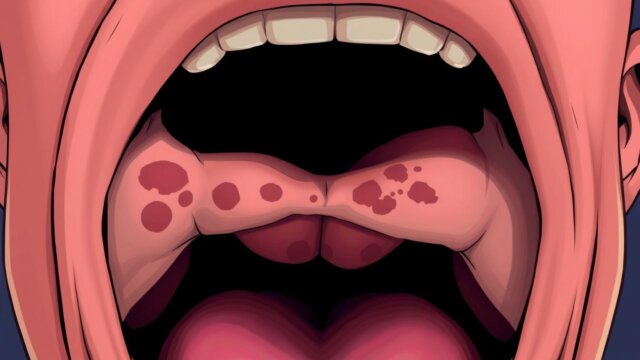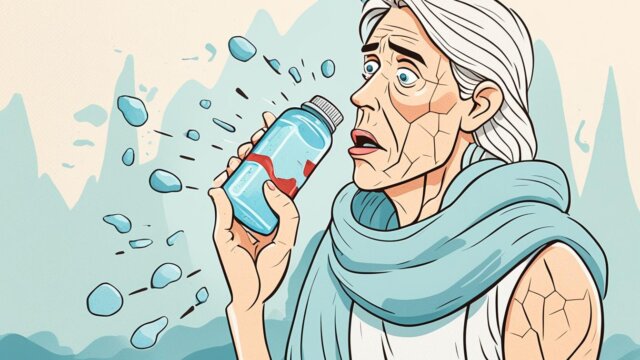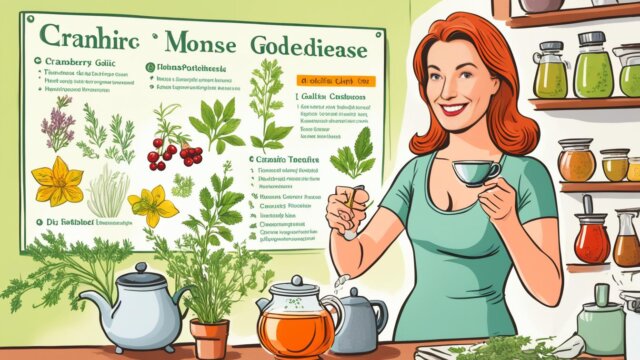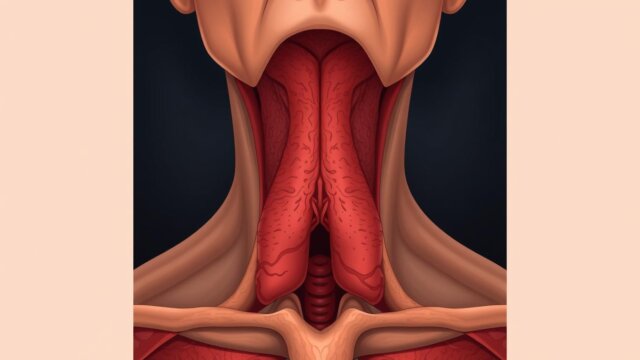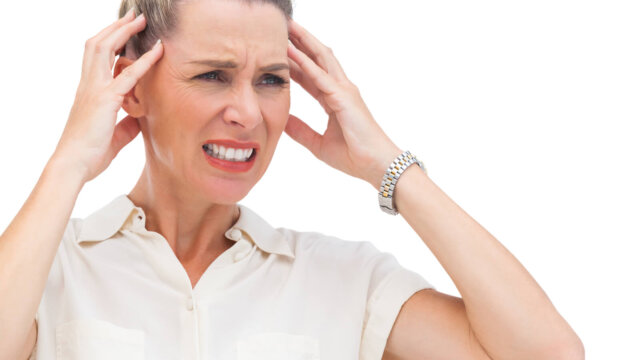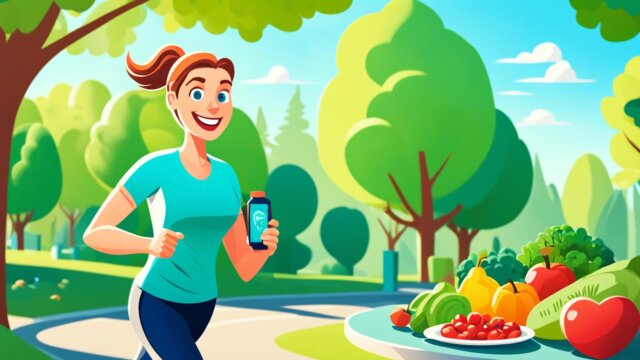FTC disclaimer: This post may contains affiliate links and we will be compensated if you click on a link and make a purchase.
Did you know that about 70% of the iron in your body makes hemoglobin? Hemoglobin is the protein in red blood cells that carries oxygen. Keeping enough iron is key for good health. But, iron deficiency is very common around the world. Luckily, there are tasty and healthy foods that can increase your iron and help you feel better.
This article will look at the best iron-rich foods for your diet. You can eat meats, seafood, spinach, and lentils to get more iron. These foods are great for preventing iron deficiency, boosting energy, or just making you healthier.
Key Takeaways
- Iron is key for making red blood cells and carrying oxygen in the body.
- Heme iron from animals is easier to absorb than non-heme iron from plants.
- Different people need different amounts of iron, with more needed during pregnancy and breastfeeding.
- Eating foods high in vitamin C can help your body absorb iron from plants better.
- Vegetarians and vegans should pay extra attention to getting enough iron because it’s harder to absorb.
What is Iron and Why is it Important?
Iron is a key mineral for your health and well-being. It’s a big part of hemoglobin, which is in red blood cells. This carries oxygen to your body’s tissues. Without enough iron, you can’t make enough hemoglobin, leading to iron deficiency anemia.
The Role of Iron in the Body
Iron helps with oxygen transport, energy production, immune function, and brain development. It turns food into energy, fights infections, and helps your brain work right. Not having enough iron can make you feel tired, weak, and your head might hurt. You might also have trouble focusing.
Consequences of Iron Deficiency
About 10 million people in the U.S. don’t have enough iron. Around 5 million Americans have iron deficiency anemia. If not treated, iron deficiency can really hurt you. It can make you less sharp mentally, lower your physical performance, and make you more likely to get sick.
“Iron is essential for the proper functioning of the body, and its deficiency can have far-reaching consequences on our health and well-being.”
Heme vs Non-Heme Iron
There are two main types of dietary iron: heme and non-heme. Knowing the difference is key for getting enough iron and making it work for your body.
Heme iron is easy for the body to use and is in animal foods like meat, poultry, and seafood. Non-heme iron is in plants like fruits, veggies, and grains but is harder for the body to use.
Heme iron is better absorbed than non-heme iron. It makes up about 10% to 15% of the iron we eat in the West. But it’s about 40% of what we absorb. Non-heme iron is absorbed less, from 5% to 12%, depending on our diet and health.
Some people need more iron, like pregnant women, women with heavy periods, kids, the elderly, vegetarians, athletes, and those on dialysis. Eating foods high in heme iron helps these groups a lot.
In short, heme iron is easier for the body to use than non-heme iron. Knowing this helps people make better food choices for their health.
Recommended Daily Iron Intake
It’s key to eat a balanced diet with enough iron for good health. How much iron you need changes with your age and gender. Adult men should get 8 milligrams of iron daily, while adult women need 18 milligrams. Some groups, like teens and pregnant or breastfeeding women, need more.
Iron Needs by Age and Gender
When pregnant, you should get 27 milligrams of iron a day to help your baby grow. If you eat mostly plants, you might need almost twice as much iron because plant iron is harder to absorb.
Increased Requirements During Pregnancy and Breastfeeding
Some groups are more likely to lack iron, like teen girls, women with heavy periods, and those with certain health issues. In the U.S., iron shortage is common in young kids, women under 50, pregnant women, and vegetarians or vegans.
Feeling tired, weak, or having trouble focusing can be signs of not getting enough iron. Making sure you get enough iron is key for staying healthy.
Meats High in Iron
Meat is a great way to get more iron. Beef, lamb, pork, and liver are top choices for heme iron. This type of iron is easy for your body to use. A small piece of beef or lamb gives you about 2.5 milligrams of iron. Beef liver gives you a big 5 milligrams.
Meat | Iron Content (3.5 oz serving) | Percentage of Daily Value |
|---|---|---|
Beef Liver | 6.5 mg | 36% |
Ground Beef | 2.7 mg | 15% |
Dark Turkey Meat | 1.4 mg | 8% |
Liver is packed with iron, giving you 36% of what you need daily in just 3.5 ounces. Ground beef also has a lot of iron, giving you 15% of your daily need in one serving.
Adding these iron-rich meats to your meals can really help your iron levels. 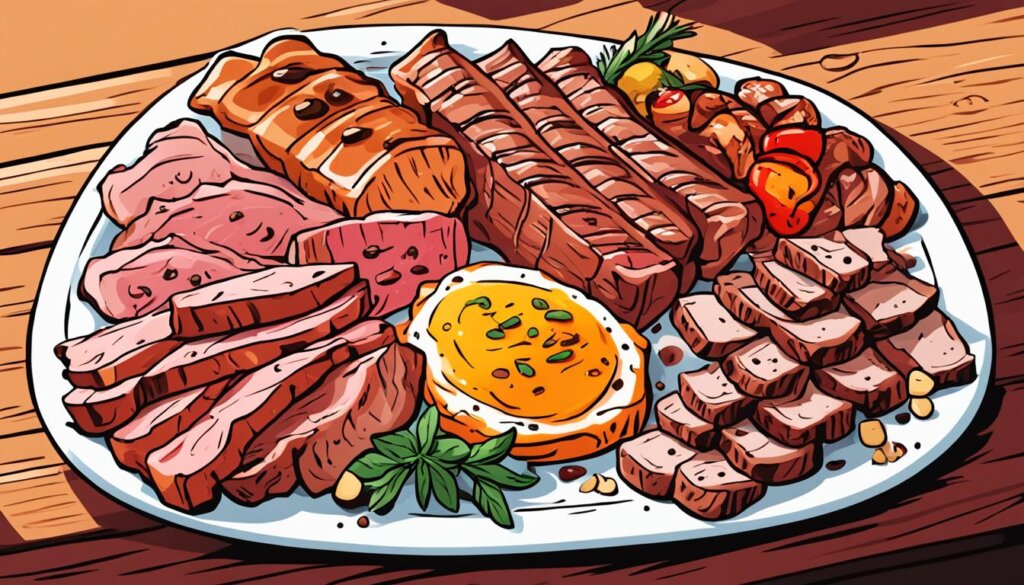
Seafood Rich in Iron
Seafood is a great way to get iron. Oysters, mussels, and shellfish are full of iron. A 3-ounce serving of oysters has about 8 milligrams. Mussels and oysters give you up to 7 milligrams of iron per 100 grams.
Fish like tuna, sardines, and mackerel are also iron-rich. A 3-ounce tuna serving has around 1.4 milligrams. Cooked tuna can have 0.9 to 1.6 milligrams per 100 grams.
Oysters, Mussels, and Other Shellfish
Shellfish like oysters, mussels, clams, and scallops are packed with iron. A 100-gram serving of clams has up to 3 milligrams of iron. Cooked mussels and oysters give you up to 7 milligrams of iron per 100 grams.
Scallops have about 0.58 milligrams of iron in 100 grams. Cooked shrimp has around 0.5 milligrams of iron per 100 grams. Canned shrimp can have up to 2.1 milligrams of iron per 100 grams.
Fish and Iron Content
Fish are also great for iron. Sardines give you about 2.9 milligrams of iron in a 100-gram serving. Salmon has around 0.3 milligrams of iron in 100 grams.
Canned tuna may have 1.4 milligrams of iron in an 85-gram serving. Cooked Yellowfin or Skipjack tuna ranges from 0.9 to 1.6 milligrams per 100 grams. Octopus can have up to 5.3 milligrams of iron per 100 grams raw, and up to 9.5 milligrams when cooked.
Eating iron-rich seafood like oysters, mussels, and fish is a great way to increase your iron intake. It supports your overall health.
Vegetables Packed with Iron
Vegetables are great for boosting your iron levels. They offer non-heme iron, which is as good as heme iron from meat and seafood.
Spinach, kale, broccoli, beet greens, and Swiss chard are full of iron. A cup of cooked spinach has about 6 milligrams. Artichoke, asparagus, and potatoes also have a lot of iron, with 1 mg, 1.5 mg, and 2 mg per cup, respectively.
Other veggies like bok choy, Brussels sprouts, chanterelle mushrooms, chickpeas, and dried seaweed are also good for iron. They have 1.8 mg to 4 mg of iron per cup. Lentils and soybeans, including tofu, have 6.5 mg and 9 mg of iron per cup.
To get the most iron from these veggies, eat them with foods high in vitamin C. Citrus fruits, tomatoes, or broccoli work well. This way, you can better use the iron your body needs.
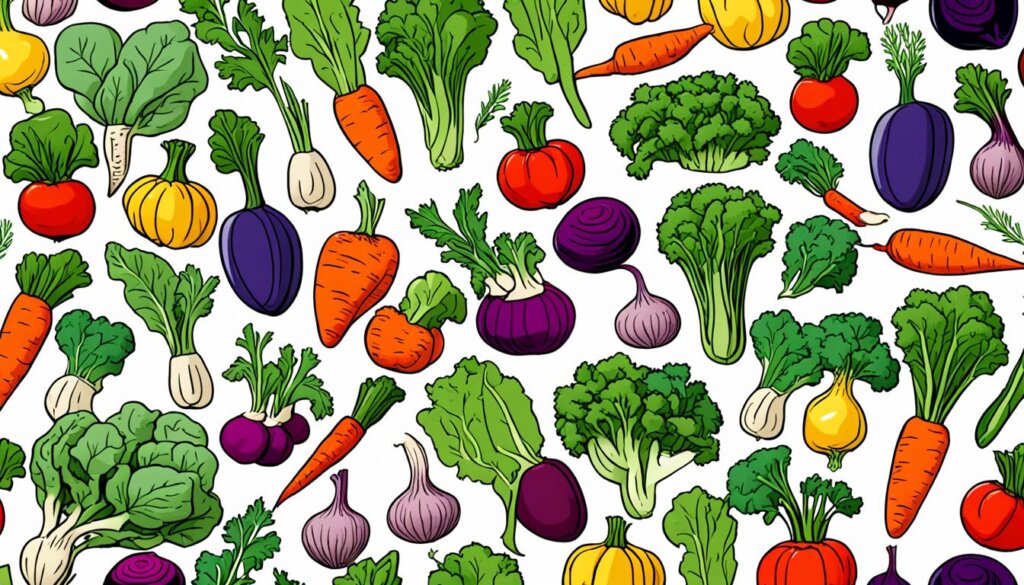
Adding these iron-rich veggies to your meals is easy and tasty. You can use leafy greens, root veggies, or legumes. There are many ways to enjoy the iron they provide.
Vegetable | Iron Content (per cup) |
|---|---|
Spinach (cooked) | Over 2 mg |
Kale | Nearly 1 mg |
Broccoli | Close to 1 mg |
Beet Greens | Around 4 mg |
Swiss Chard | Almost 4 mg |
Adding these iron-rich veggies to your diet can help you get more iron. This supports your health and well-being. Always talk to a healthcare provider before taking iron supplements or if you have iron level concerns.
Fruits as Sources of Iron
Fruits aren’t usually seen as iron-rich, but some types have good amounts of this key mineral. Iron-rich fruits like berries, watermelon, figs, and prunes are great for your diet. Dried fruits are especially packed with iron. For example, a 1/4 cup of dried apricots or raisins gives about 1 milligram of iron.
Dried Fruits and Iron
Dried fruits such as apricots, raisins, figs, and prunes are full of iron. A 1/4 cup of these iron-rich fruits can give you up to 1 milligram of iron. Adding a source of vitamin C, like citrus fruits or berries, can help your body absorb more iron.
Iron-Rich Fruit | Iron Content per Serving |
|---|---|
Dried Apricots (1/4 cup) | 1 mg |
Raisins (1/4 cup) | 1 mg |
Dried Figs (1/4 cup) | 0.9 mg |
Dried Prunes (1/4 cup) | 0.8 mg |
Adding iron-rich fruits, especially dried fruits, to your meals can help you get the iron you need. This supports your health and well-being.
Other Iron-Rich Foods
Legumes, Nuts, and Fortified Grains
There are many foods besides meats, seafood, veggies, and fruits that are good for iron. Iron-rich legumes, like beans, lentils, and chickpeas, are great choices. Nuts and seeds, including cashews and pumpkin seeds, also have a lot of iron. Plus, many breakfast cereals and fortified grains are good for getting more iron.
- Ready-to-eat cereal, whole grain kernels, fortified contains 16.2 mg of iron per 1/2 cup serving with 209 calories.
- Oysters provide 6.9 mg of iron in 3 oysters serving with 123 calories.
- Spinach, cooked, has 6.4 mg of iron in a 1 cup serving with 41 calories.
- Beef offers 2.5 mg of iron per 3-ounce portion with 173 calories.
- Prune juice provides 3.0 mg of iron in a 1 cup serving with 182 calories.
- Sesame seeds contain 2.1 mg of iron in a 1/2 ounce serving with 81 calories.
- Turkey Egg contributes 3.2 mg of iron per egg with 135 calories.
- Lima beans cooked, offers 4.2 mg of iron in a 1 cup serving with 209 calories.
- Prune juice, 100%, contains 1.5 mg of iron in a 1/2 cup serving with 91 calories.
- Cashews have 1.9 mg of iron in a 1 ounce serving with 157 calories.
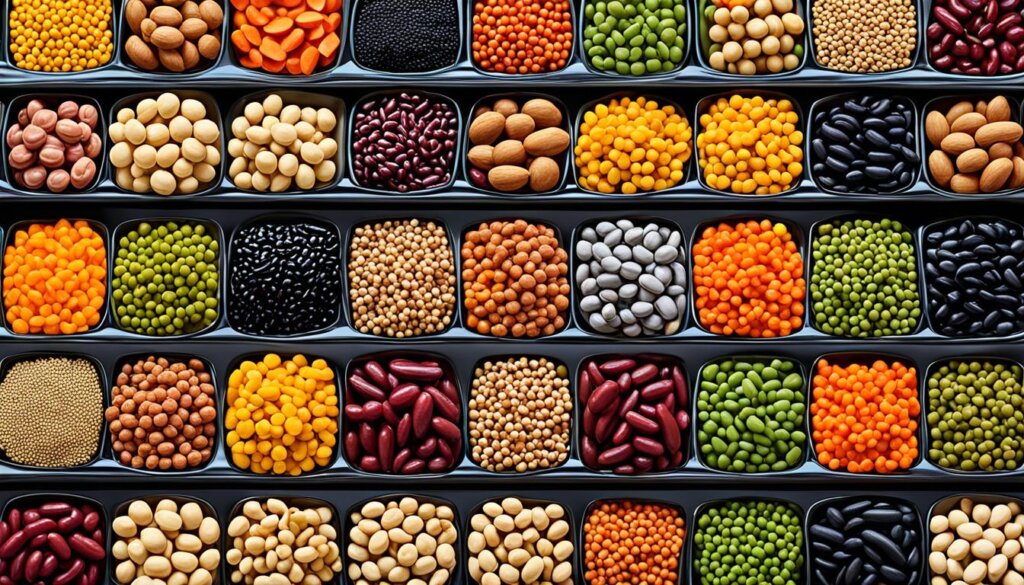
“Incorporating a variety of iron-rich foods, including legumes, nuts, and fortified grains, can help ensure you meet your daily iron needs and support overall health.”
Enhancing Iron Absorption
What you eat and drink affects how your body takes in iron. Foods high in vitamin C, like citrus fruits, tomatoes, and peppers, help your body use iron better from plants. But, things like coffee, tea, and foods high in calcium can lower iron absorption. So, eat these separately from iron-rich foods.
Vitamin C and Iron Absorption
Vitamin C boosts iron absorption a lot. Eating foods high in vitamin C with iron can make your body use iron from plants better. This is key for vegetarians or vegans, as they often have less iron than meat-eaters.
Great vitamin C sources for better iron absorption are citrus fruits, peppers, tomatoes, strawberries, and potatoes. Adding these foods to your meals helps your body take in more iron.
“Consuming vitamin C-rich foods during meals enhances the absorption of non-heme iron from plant-based sources.”
Iron-Rich Foods for Vegetarians and Vegans
For vegetarians and vegans, getting enough iron can be harder. This is because iron from plants, called non-heme iron, isn’t as good as iron from meat and seafood. But, there are many iron-rich foods that can help meet daily needs.
Great iron sources for vegetarians include tofu, quinoa, lentils, cashews, and fortified cereals. Tofu has 6.6 milligrams of iron per half-cup, and tempeh has 4.5 milligrams per cup. Quinoa is packed with 2.8 milligrams of iron per cooked cup. Lentils give 6.6 milligrams of iron per cup.
Eating foods high in vitamin C, like bell peppers, broccoli, and citrus fruits, can boost iron absorption. Vitamin C makes iron easier for the body to use.
Vegetarians and vegans might need more iron than meat-eaters because non-heme iron is harder to absorb. By eating iron-rich plants and foods high in vitamin C, they can get enough iron for good health.
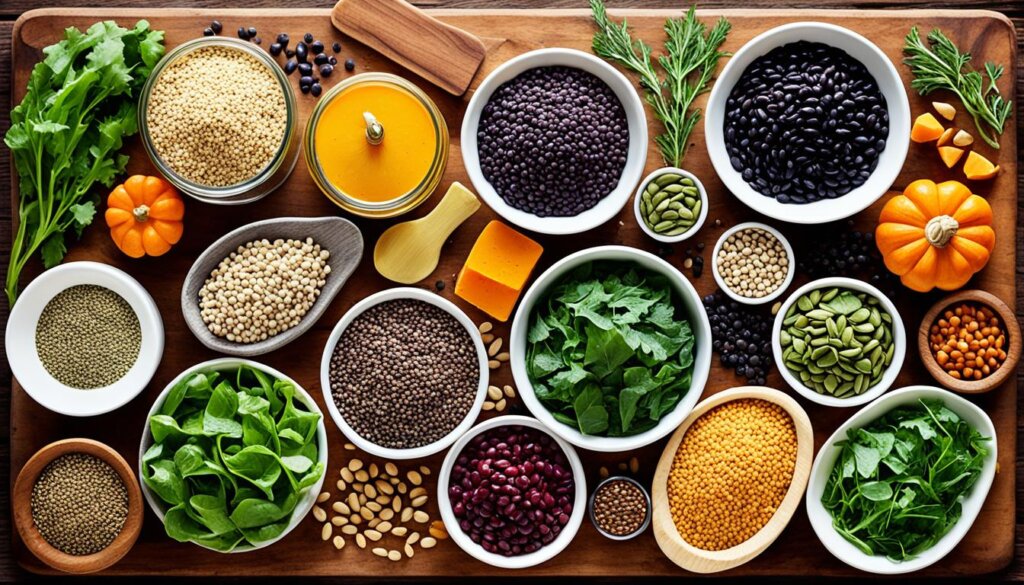
Food | Iron Content |
|---|---|
Tofu | 6.6 mg per 1/2 cup |
Quinoa | 2.8 mg per cooked cup |
Lentils | 6.6 mg per cup |
Cashews | 1.9 mg per 1 ounce |
Fortified Cereals | Varies, check nutrition label |
Iron Supplements: When to Consider Them
Getting iron from food is best, but sometimes supplements are needed. If diet alone doesn’t give you enough iron, or if you have iron deficiency anemia, your doctor might suggest iron supplements like ferrous sulfate. Always talk to your doctor before taking iron supplements because they can affect other medicines and have side effects.
How well your body absorbs iron changes a lot. It drops from 20% to 10% as ferritin levels go up from 15 to 60 mg/dL. Women before menopause often have trouble with iron levels, with about half facing this problem. Women usually have less iron than men. So, it’s key to get enough iron from food and supplements if needed.
- Iron deficiency affects about 10 million people in the U.S., with 5 million suffering from iron deficiency anemia.
- Menstruation is the most common cause of iron deficiency in women of childbearing age, with women losing around 30 milligrams of iron per month due to blood loss.
- Iron deficiency can lead to nonspecific symptoms, such as fatigue, weakness, lightheadedness, and brittle nails.
When taking iron supplements, start with 14mg once a day, or up to 14mg twice a day if needed. Spread out your doses during the day to help your body absorb it better. It’s important to get advice from a doctor if you keep having low iron levels even with supplements.
Eating foods high in iron, like red meat, seafood, and dark leafy greens, can boost your iron levels. Adding vitamin C-rich foods to these can make iron absorption better.
“Paying attention to your iron levels and addressing any deficiencies through a combination of diet and supplements, if necessary, can help you maintain optimal health and energy levels.”
Risks of Too Much Iron
Iron deficiency is common, but having too much iron is also a problem. This is called iron overload or hemochromatosis. It can happen if you take too many iron supplements or have a condition that makes your body store too much iron. Too much iron can cause serious health issues. So, always take iron supplements with a doctor’s advice.
Taking too much iron from supplements can be dangerous. Even a small amount can cause symptoms of iron poisoning. If you take more than 40 mg/kg, you need medical help. Taking more than 60 mg/kg can be deadly.
Too much iron can cause iron toxicity. This can harm organs. It can even damage the liver or brain. Iron can affect the liver, other organs, and blood.
Hereditary hemochromatosis is a common iron overload disorder. It raises the risk of many health problems like arthritis, cancer, and liver issues. It can also cause skin to look bronze and lead to liver cirrhosis.
Studies show that too much heme iron from supplements or red meat might increase colon cancer risk. Heme iron can also create harmful compounds in the digestive tract.
Iron overload and deficiency can weaken the immune system. Taking iron supplements can make infections more common in some people. People with hereditary hemochromatosis are more likely to get infections.
In summary, too much iron is dangerous. Be careful with iron supplements unless a doctor says it’s okay. Too much iron can cause serious health problems. It’s important to get the right amount of iron to avoid both deficiency and overload.
Iron-Rich Foods for Better Health
Adding iron-rich foods to your meals is key for good health. You can get iron from meats, seafood, veggies, fruits, and more. Eating a mix of iron-rich foods helps prevent anemia, increases energy, and keeps your body working right. By eating iron-rich foods often, you help support your health and happiness.
Some top iron-rich foods are:
- Clams, with up to 17% of the daily value (DV) of iron per serving
- Beef liver, giving 36% of the DV of iron per serving
- Lentils, with 37% of the DV of iron per cup
- Ground beef, offering 15% of the DV of iron per serving
- Pumpkin seeds, with 14% of the DV of iron per ounce
- Quinoa, providing 16% of the DV of iron per cup
- Dark turkey meat, giving 8% of the DV of iron per serving
- Broccoli, with 6% of the DV of iron per cup
Adding these and other iron-rich foods to your meals helps your body get enough iron intake. This is key for healthy blood, energy, and overall well-being.
“Eating a variety of iron-rich foods is the best way to boost your iron intake and support your overall health.”
Conclusion
Iron is a key mineral for your body’s health and working well. It helps with thinking, brain growth, and fighting off sickness. Knowing about iron, its types, and iron-rich foods helps you eat better and feel better too.
Some foods have a lot of iron, like cooked beef, beans, tofu, artichoke, spinach, oatmeal, and corn flakes. Eating foods high in vitamin C, like orange juice, strawberries, and sweet yellow pepper, can help your body use iron better. But, don’t eat iron-rich foods with things high in calcium, as that can stop iron from being absorbed.
If you’re worried about your iron levels, talk to your doctor. People who eat less meat, are athletes, or have ongoing health issues should watch their iron levels closely. With the right food choices, you can manage your iron intake and enjoy its many benefits.
FAQ
What is iron and why is it important?
Iron is a key mineral for your body. It’s part of hemoglobin, which carries oxygen in red blood cells. Iron also helps with energy, fighting off infections, and brain growth.
What are the consequences of iron deficiency?
Not getting enough iron can lead to iron deficiency anemia. This makes you feel tired, weak, and gives you headaches. It also makes it hard to focus.
What is the difference between heme and non-heme iron?
Heme iron is easy for the body to absorb and is found in animal foods like meat and fish. Non-heme iron is harder to absorb but is in plant foods like fruits and grains. Both types are important for a healthy diet.
What is the recommended daily intake of iron?
Iron needs vary by age and gender. Adults need 8 milligrams a day, while women need 18 milligrams. Teenagers and those pregnant or breastfeeding need more.
What are some of the best meat-based sources of iron?
Great iron sources include beef, lamb, pork, and liver. A 3-ounce beef or lamb serving gives about 2.5 milligrams of iron. Beef liver gives a whopping 5 milligrams in the same amount.
What are some of the best seafood sources of iron?
Oysters, mussels, and shellfish are high in iron. A 3-ounce oyster serving has about 8 milligrams. Tuna, sardines, and mackerel also offer good iron, with tuna giving about 1 milligram per 3 ounces.
What are some of the best vegetable sources of iron?
Spinach, kale, broccoli, beet greens, and Swiss chard are iron-rich. A cup of cooked spinach has about 6 milligrams.
What are some good fruit sources of iron?
Some fruits like strawberries, watermelon, figs, and prunes are good for iron. Dried fruits like apricots and raisins are also rich in iron, with a quarter cup giving about 1 milligram.
What are some other iron-rich foods?
Besides meats, seafood, veggies, and fruits, other foods are iron-rich. Legumes like beans and lentils are full of iron. Nuts and seeds, such as cashews, are also good. Many cereals and grains are iron-fortified too.
How can you enhance iron absorption?
Foods high in vitamin C, like citrus fruits, help absorb iron from plants. But coffee, tea, and foods high in calcium can lower iron absorption. Eat these separately from iron-rich foods.
How can vegetarians and vegans get enough iron?
Getting enough iron can be harder for vegetarians and vegans. But, there are many iron-rich plant foods like tofu, quinoa, lentils, and cashews. Vitamin C-rich foods can help make iron absorption better.
When should you consider taking iron supplements?
Iron supplements might be needed if diet alone doesn’t meet your iron needs or if you have iron deficiency anemia. A healthcare provider may suggest supplements like ferrous sulfate.
What are the risks of too much iron?
Too much iron, known as iron overload or hemochromatosis, can be harmful. It can happen with too many supplements or certain genetic conditions. Too much iron can cause serious health issues, so always take supplements with a doctor’s advice.
